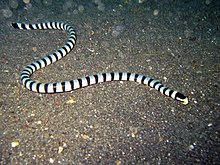Sea krait
| Sea krait | |
|---|---|

| |
Laticauda colubrina
| |
| Scientific classification | |
| Domain: | Eukaryota |
| Kingdom: | Animalia |
| Phylum: | Chordata |
| Class: | Reptilia |
| Order: | Squamata |
| Suborder: | Serpentes |
| Family: | Elapidae |
| Subfamily: | Laticaudinae Cope, 1876 |
| Genus: | Laticauda Laurenti, 1768 |
| Type species | |
Laticauda laticaudata
, 1758) | |
| Species | |
|
Eight, see text | |
Sea kraits are a genus of venomous elapid sea snakes (subfamily: Laticaudinae), Laticauda. They are semiaquatic, and retain the wide ventral scales typical of terrestrial snakes for moving on land, but also have paddle-shaped tails for swimming.[1] Unlike fully aquatic ovoviviparous sea snakes, sea kraits are oviparous and must come to land to digest prey and lay eggs.[2] They also have independent evolutionary origins into aquatic habitats, with sea kraits diverging earlier from other Australasian elapids.[3][4] Thus, sea kraits and sea snakes are an example of convergent evolution into aquatic habitats within the Hydrophiinae snakes. Sea kraits are also often confused with land kraits (genus Bungarus), which are not aquatic.
Description
Sea kraits are
Location
Laticauda species are found throughout the South and Southeast Asian islands spreading from India in the west, north as far as Japan, and southeast to Fiji. The species occasionally wanders south to the
Diet
Laticauda species feed in the ocean, mostly eating
Behavior
Laticauda species are often active at night, which is when they prefer to hunt. Though they possess highly toxic venom, these snakes are usually shy and reclusive, and in
Breeding
Laticauda females are
Species and taxonomy
Eight species are currently recognised as being valid.[15][16]
- Laticauda colubrina (Schneider, 1799) – yellow-lipped sea krait
- Laticauda crockeri Slevin, 1934 – Crocker's sea snake
- Laticauda frontalis (De Vis, 1905)
- Laticauda guineai Heatwole, Busack & Cogger, 2005 – Guinea's sea krait[17]
- ) – blue-lipped sea krait
- Laticauda saintgironsi Cogger & Heatwole, 2006 – New Caledoniansea krait
- Laticauda schistorhyncha (Günther, 1874) – katuali or Niue sea krait
- Laticauda semifasciata (Reinwardt in Schlegel, 1837) – black-banded sea krait
The species L. schistorhyncha and L. semifasciata have been placed in the genus Pseudolaticauda by some authors.[18]
Nota bene: A binomial authority in parentheses indicates that the species was originally described in a genus other than Laticauda.
Parasites
Sea snakes can have parasitic ticks, occasionally with heavy infestations.[19]
References
- ^ a b c Wilson, Stephen K.; Swan, Gerry (2013). A Complete Guide to Reptiles of Australia. Chatswood, New South Wales: New Holland Publishers. p. 564.
- ^ a b Cogger, Hal (2000). Reptiles and Amphibians of Australia. Sydney, NSW: Reed New Holland. p. 722.
- PMID 21074626.
- .
- S2CID 82676695.
- .
- ^ Shine, Richard; Shetty, Sohan (2002). "Activity Patterns of Yellow-Lipped Sea Kraits (Laticauda colubrina) on a Fijian Island". Copeia 2002 (1): 77-85.
- ^ Wikidata Q58629017.
- )
- ^ "La Lettre de la Délégation n°202". Notes du Centre d'Études Biologiques de Chizé (UPR1934 CNRS) (CNRS DR15) (in French). 202. 2016-03-29. Archived from the original on 2017-03-23. Retrieved 2017-03-23.
- ^ "Black-banded sea krait photo - Laticauda semifasciata - G78940". Archived from the original on 2012-10-08. Retrieved 2011-07-30.
- ^ "BBC Earth - Programmes - Planet Earth". Archived from the original on 2012-03-11. Retrieved 2015-08-18.
- .
- ISSN 0171-8630.
- ^ Heatwole H, Busack S, Cogger H (2005). "Geographic variation in sea kraits of the Laticauda colubrina complex (Serpentes: Elapidae: Hydrophiinae: Laticaudini)". Herpetological Monographs 19: 1-136.
- ^ Cogger HG, Heatwole HF (2006). "Laticauda frontalis (de Vis, 1905) and Laticauda saintgironsi n.sp. from Vanuato and New Caledonia (Serpentes: Elapidae: Laticaudinae) – a new lineage of sea kraits?" Records of the Australian Museum 58: 245-256.
- ISBN 978-1-4214-0135-5. (Laticauda guineai, p. 112).
- ^ Kharin VE, Czeblukov VP (2006). "A new revision of the sea kraits of family Laticaudidae Cope, 1879 (Serpentes: Colubroidea)". Russian Journal of Herpetology 13: 227-241.
- ^ "Sea snake parasites – 1". Tropical Research and Conservation Centre. 8 March 2011. Archived from the original on 2 April 2012. Retrieved 9 October 2017.
Further reading
- Laurenti JN (1768). Specimen medicum, exhibens synopsin reptilium emendatam cum experimentis circa venena et antidota reptilium austriacorum. Vienna: "Joan. Thom. Nob. de Trattnern". 214 pp. + Plates I-V. (Laticauda, new genus, p. 109). (in Latin).
External links
- Sea krait slithering on coastal rocks. https://www.youtube.com/watch?v=KAe69AlIvR4
